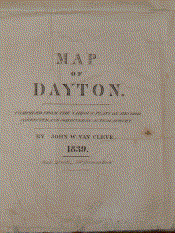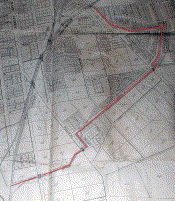

"
Seely's Ditch Map
on
VAN CLEVE'S 1839, MAP
"
MEMOIRS OF THE MIAMI VALLEY - Volume One
John W. VanCleve was born, June 27, 1801, and tradition says he was the first male child born in Dayton. His father was Benjamin VanCleve, heretofore mentioned as one of the band of settlers who arrived in Dayton, April 1, 1796. John W. VanCleve from his earliest years gave evidence of a vigorous intellect and of a retentive memory. At the age of sixteen he entered the Ohio university at Athens, and so distinguished himself for proficiency in Latin that he was employed to teach that language in the college before his graduation. In after life he mastered both the French and German languages and made several translations of important German works. He studied law in the office of judge Joseph McCrane, and was admitted to the bar in 1828. Not finding the practice of the law congenial, he purchased an interest in the Dayton journal and edited that paper until 1834. After being engaged in other business for a few years, in 1851 he retired and gave the remainder of his life to his studies and to- whatever could beneft and adorn his native city., He was elected and served as mayor of the city in 1831-32. He also served at various times as city civil engineer, and in 1839 compiled and lithographed a map of the city. He was an ardent Whig and entered enthusiastically into the celebrated political campaign of 1840, writing many of the songs and furnishing the engravings for a campaign paper, called the Log Cabin, which attained great notoriety throughout the United States. He was the founder of Dayton Library association, afterward merged in the public library, and the invaluable volumes of early Dayton newspapers, from 1808 to 1847, was his gift to the library. It was his suggestion to plant the levees with shade trees, and the first trees were selected by him and planted under his direction. But the chief work for which the city is indebted to him is the foresight which secured the admirable site for the Woodland cemetery, before it was appropriated to other uses. In 1840, when the cemetery association was organized, public attention had not been generally called to the importance and desirability of rural cemeteries, and the suggestion at that time of a rural cemetery for Dayton was in advance of the times. Woodland cemetery is the third rural cemetery in order of time in the United States, preceding Spring Grove at Cincinnati three years. To Mr. VanCleve the honor is due of suggesting the cemetery and persistently carrying it through to completion. Mr. VanCleve died, Sept. 6, 1858, at the comparatively early age of fifty-seven years.